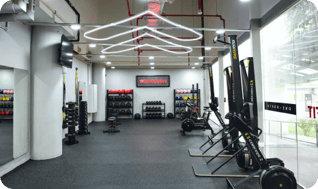Injuries can be incredibly frustrating, especially if you're someone who relies on physical activity for mental well-being, fitness goals, or just as a way to escape daily stress. But being injured doesn’t mean you have to completely halt your progress. With a thoughtful approach and the right guidance, you can continue training in ways that support healing and prevent further damage. Here, I’ll explore how UFIT helps clients maintain activity levels during injuries, why a physiotherapist assessment is crucial, and what adjustments can keep you on track.
The Myth: Pain Means You Must Stop
A common misconception is that pain immediately signals a stop to all exercise. While resting the affected area can sometimes be necessary, complete cessation of all physical activity isn’t always the answer. Instead, working with a physiotherapist to determine what type of exercise is safe and beneficial is a proactive approach to staying active without compromising recovery.
For instance, I once worked with a runner experiencing knee pain. After a thorough assessment, we identified that speed work was the primary trigger. Instead of sidelining all running activities, we tailored their plan to include slow, easy runs, focusing on addressing the cause of their discomfort. By carefully adapting their training, they were able to continue doing what they loved while minimising further strain on their knee.
Step 1: Getting Assessed by a Physiotherapist

The first, and perhaps most important, step in training with an injury is to seek an assessment. Physiotherapists can evaluate the nature and severity of the injury and identify any underlying issues contributing to the pain. They’ll assess the movements and activities that cause discomfort, helping to determine whether it’s safe to continue training and, if so, in what ways.
At UFIT, we believe in taking an individualised approach with each client, understanding not only the physical aspects of the injury but also the person’s motivations. Everyone has their reasons for staying active, from mental health benefits to simply enjoying time outdoors or away from the desk. This understanding allows us to tailor our recommendations to suit each client’s needs and goals, so they can keep moving while working towards recovery.
It’s essential to avoid a blanket recommendation to “just rest” unless absolutely necessary. The right physiotherapist will empower you to stay active, exploring ways to train around the injury, rather than enforcing complete inactivity.
Step 2: Adapting Your Training Plan

Once a physiotherapist confirms it’s safe to continue exercising, it’s time to modify your routine. Adaptation is key to ensuring you’re not putting undue stress on the injury while still working towards your goals. This might involve reducing the intensity, frequency, or type of exercise.
Using the example of my runner client, we replaced their speed intervals with slower, steady runs. This adjustment kept them moving, preserved their cardiovascular fitness, and allowed us to monitor their progress while addressing the root cause of their knee pain through targeted strength work. For others, it might mean incorporating more controlled movements or lower-impact exercises to reduce the strain on the injured area.
Some Adaptations to Consider:
- Reduce Impact: If high-impact activities like running are causing pain, consider switching to lower-impact exercises such as cycling, swimming, or using an elliptical machine. These can offer cardiovascular benefits with less pressure on joints or injured areas.
- Modify Movements: For those with shoulder or upper body issues, substituting exercises like push-ups with alternative, controlled movements such as band work or single-arm exercises can allow muscle engagement without the same level of stress.
- Use Cross-Training: Cross-training can be a lifeline for maintaining fitness during injury. If running is off the table, biking or swimming can help keep cardiovascular endurance intact while reducing the load on injured joints. Cross-training can also introduce new movements that improve your overall resilience and reduce the risk of re-injury.
Step 3: Building Around the Injury, Not Through It
Continuing to push through pain without adjustments can delay recovery and even worsen the injury. At UFIT, we emphasise “training around” the injury rather than through it. This means staying active in ways that don’t aggravate the issue while working on addressing the underlying cause.
Step 4: Resting When It’s Truly Necessary
There are times when true rest for the injured area is non-negotiable. A physiotherapist may determine that specific activities or movements need to be paused for a period. However, rest doesn’t always mean complete inactivity. We can often recommend alternative forms of exercise to keep you active. A realistic plan with goals should be made with your physiotherapist on the timeline of returning to full activities.
Why Mental Health Matters
One of the biggest challenges of training around an injury is the psychological impact. For many people, exercise is more than a physical activity; it’s a time to destress, clear the mind, and feel accomplished. Injuries can disrupt this routine, which is why we consider each client’s motivations when designing their plan. Maintaining some level of activity can significantly boost mental well-being and help clients feel that they’re still progressing, even if in a different way.
By staying active, clients maintain not only their physical fitness but also their mental health. This sense of normalcy can be instrumental in helping them handle the injury and stay motivated throughout the recovery process.
Preventing Re-injury and Moving Forward
Training while injured requires caution and commitment to avoid setbacks. Working closely with a physiotherapist allows you to strengthen areas that may have contributed to the injury and focus on building resilience. This proactive approach can reduce the risk of future injuries and help you return to your preferred activities stronger than before.
For example, the runner with knee pain didn’t just stick to slow runs indefinitely. They worked closely with the physiotherapist on strengthening the muscles that support the knee, addressing gait issues, and progressively reintroducing speed work as their condition improved. This methodical approach not only kept them active but also equipped them with tools to reduce the risk of future knee pain.
Conclusion: Listen to Your Body, but Don’t Be Afraid to Adapt
Injuries are undoubtedly setbacks, but they don’t have to mean the end of your progress. With the right guidance, you can continue training, adapting your routine to stay active and engaged. At UFIT, we’re committed to understanding our clients’ motivations and creating a safe, supportive environment for them to work around injuries without compromising recovery.
If you’re dealing with an injury, don’t hesitate to seek an assessment and explore your options. Every setback offers an opportunity to learn, adapt, and grow stronger. Let’s work together to keep you moving forward, doing what you love—because pain doesn’t have to mean you have to stop.
/01%20Pages/01%20About/Team/Jade%20Sarseo%20540.webp?width=290&name=Jade%20Sarseo%20540.webp)

.png?width=301&height=187&name=Website%20Navigation%20Images%20(3).png)

-1.jpg?width=1984&height=1196&name=UFIT%20Club%20Street%20Front%20(4)-1.jpg)






